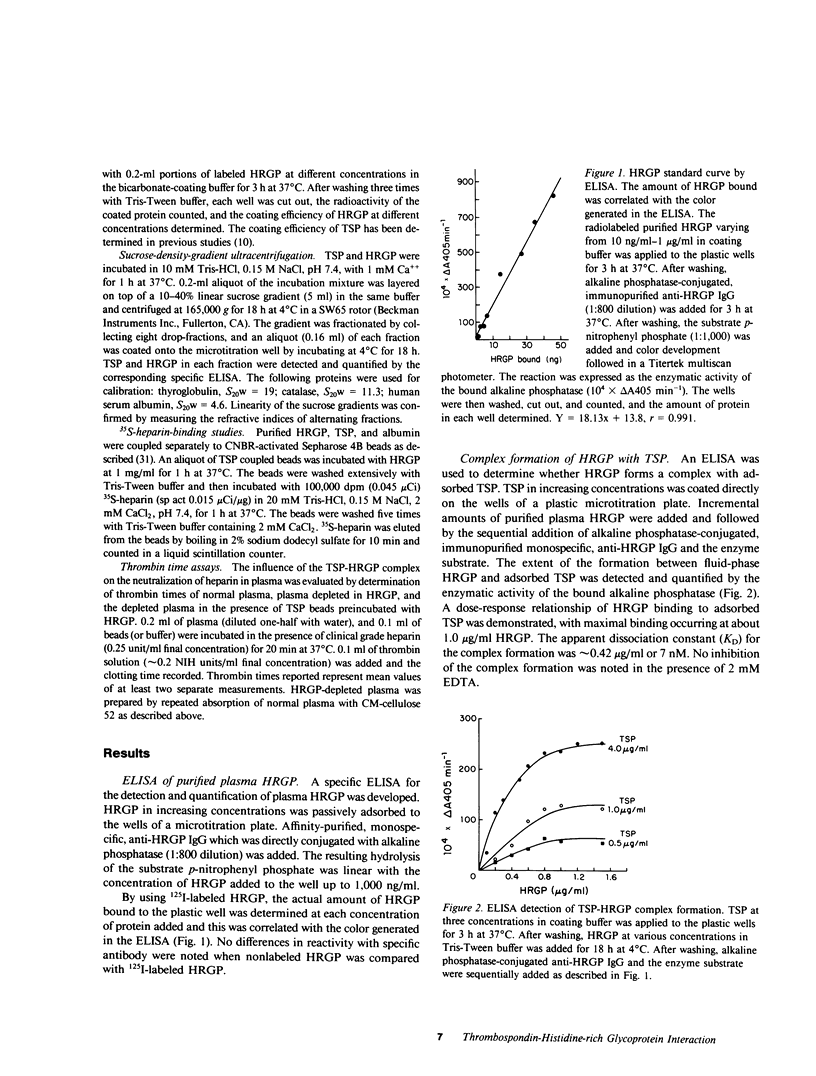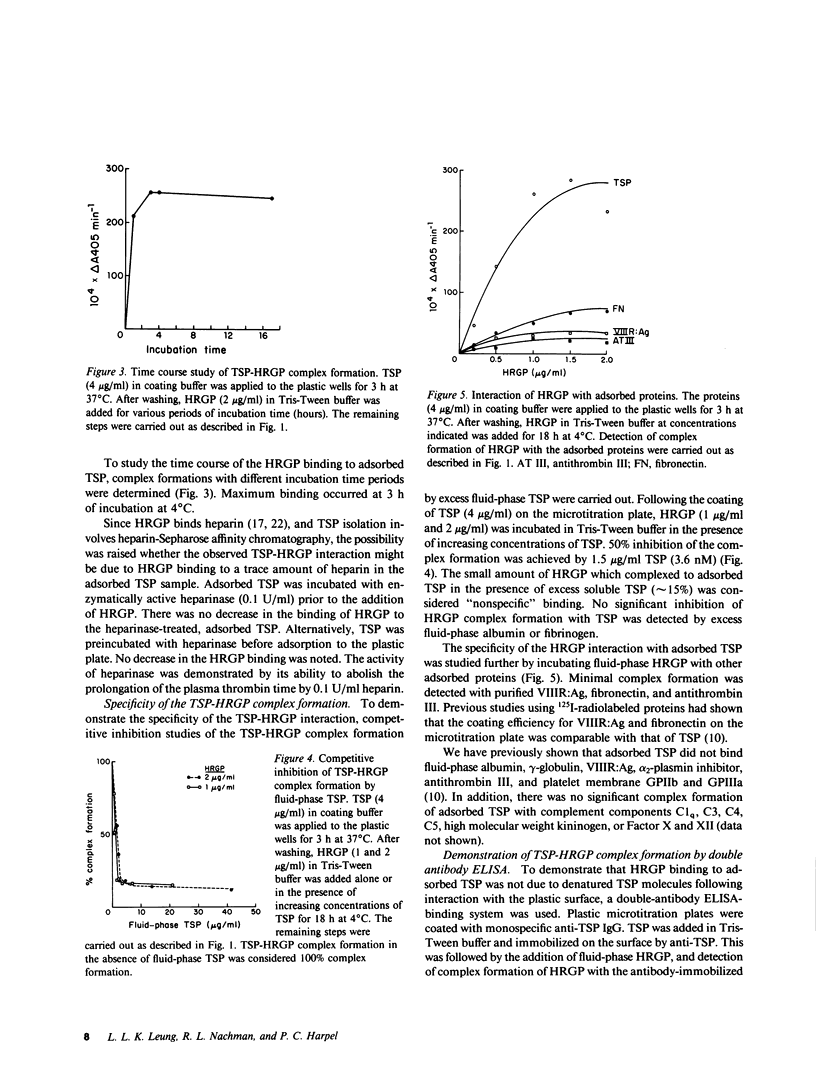Abstract
Thrombospondin and histidine-rich glycoprotein are two proteins with diverse biological activities which have been associated with human platelets and other cell systems. Using an enzyme-linked immunosorbent assay, we have demonstrated that purified human platelet thrombospondin formed a complex with purified human plasma histidine-rich glycoprotein. The formation of the thrombospondin-histidine-rich glycoprotein complex was specific, concentration dependent, and saturable. Significant binding was detected when histidine-rich glycoprotein was incubated with thrombospondin immobilized on anti-thrombospondin IgG-coated plates, indicating that the observed complex formation was not due to a thrombospondin interaction with the plastic surface. Sucrose-density-gradient ultracentrifugation of a mixture of thrombospondin and histidine-rich glycoprotein also revealed the formation of fluid-phase complexes, with an estimated stoichiometry of 1 thrombospondin: 3.5 histidine-rich glycoprotein. Fibrinogen, which has been previously shown to bind to absorbed thrombospondin, did not inhibit the formation of the thrombospondin-histidine-rich glycoprotein complex. Histidine-rich glycoprotein complexed with thrombospondin was capable of binding heparin and neutralizing the anticoagulant activity of heparin in plasma. Specific complex formation between thrombospondin and histidine-rich glycoprotein may play a significant role in influencing platelet blood vessel wall interactions as well as modulating the association of various cells with the extracellular matrix.
Full text
PDF







Selected References
These references are in PubMed. This may not be the complete list of references from this article.
- Cuatrecasas P. Protein purification by affinity chromatography. Derivatizations of agarose and polyacrylamide beads. J Biol Chem. 1970 Jun;245(12):3059–3065. [PubMed] [Google Scholar]
- Gartner T. K., Gerrard J. M., White J. G., Williams D. C. Fibrinogen is the receptor for the endogenous lectin of human platelets. Nature. 1981 Feb 19;289(5799):688–690. doi: 10.1038/289688a0. [DOI] [PubMed] [Google Scholar]
- Gartner T. K., Gerrard J. M., White J. G., Williams D. C. The endogenous lectin of human platelets is an alpha-granule component. Blood. 1981 Jul;58(1):153–157. [PubMed] [Google Scholar]
- Gartner T. K., Williams D. C., Minion F. C., Phillips D. R. Thrombin-induced platelet aggregation is mediated by a platelet plasma membrane-bound lectin. Science. 1978 Jun 16;200(4347):1281–1283. doi: 10.1126/science.663608. [DOI] [PubMed] [Google Scholar]
- Gerrard J. M., Phillips D. R., Rao G. H., Plow E. F., Walz D. A., Ross R., Harker L. A., White J. G. Biochemical studies of two patients with the gray platelet syndrome. Selective deficiency of platelet alpha granules. J Clin Invest. 1980 Jul;66(1):102–109. doi: 10.1172/JCI109823. [DOI] [PMC free article] [PubMed] [Google Scholar]
- Hagen I. Effects of thrombin on washed, human platelets: changes in the subcellular fractions. Biochim Biophys Acta. 1975 Jun 12;392(2):242–254. doi: 10.1016/0304-4165(75)90006-9. [DOI] [PubMed] [Google Scholar]
- Harpel P. C. Alpha2-plasmin inhibitor and alpha2-macroglobulin-plasmin complexes in plasma. Quantitation by an enzyme-linked differential antibody immunosorbent assay. J Clin Invest. 1981 Jul;68(1):46–55. doi: 10.1172/JCI110253. [DOI] [PMC free article] [PubMed] [Google Scholar]
- Haupt H., Heimburger N. Humanserumproteine mit hoher Affinität zu Carboxymethylcellulose. I. Isolierung von Lysozym, C1q und bisher unbekannten -Globulinen. Hoppe Seylers Z Physiol Chem. 1972 Jul;353(7):1125–1132. [PubMed] [Google Scholar]
- Heimburger N., Haupt H., Kranz T., Baudner S. Humanserumproteine mit hoher Affinität zu Carboxymethylcellulose. II. Physikalisch-chemische und immunologische Charakterisierung eines histidinreichen 3,8S- 2 -Glykoproteins (CM-Protein I. Hoppe Seylers Z Physiol Chem. 1972 Jul;353(7):1133–1140. [PubMed] [Google Scholar]
- Hynes R. O., Yamada K. M. Fibronectins: multifunctional modular glycoproteins. J Cell Biol. 1982 Nov;95(2 Pt 1):369–377. doi: 10.1083/jcb.95.2.369. [DOI] [PMC free article] [PubMed] [Google Scholar]
- Jaffe E. A., Leung L. L., Nachman R. L., Levin R. I., Mosher D. F. Thrombospondin is the endogenous lectin of human platelets. Nature. 1982 Jan 21;295(5846):246–248. doi: 10.1038/295246a0. [DOI] [PubMed] [Google Scholar]
- Jaffe E. A., Nachman R. L. Subunit structure of factor VIII antigen synthesized by cultured human endothelial cells. J Clin Invest. 1975 Sep;56(3):698–702. doi: 10.1172/JCI108140. [DOI] [PMC free article] [PubMed] [Google Scholar]
- Jaffe E. A., Ruggiero J. T., Leung L. K., Doyle M. J., McKeown-Longo P. J., Mosher D. F. Cultured human fibroblasts synthesize and secrete thrombospondin and incorporate it into extracellular matrix. Proc Natl Acad Sci U S A. 1983 Feb;80(4):998–1002. doi: 10.1073/pnas.80.4.998. [DOI] [PMC free article] [PubMed] [Google Scholar]
- Lahav J., Schwartz M. A., Hynes R. O. Analysis of platelet adhesion with a radioactive chemical crosslinking reagent: interaction of thrombospondin with fibronectin and collagen. Cell. 1982 Nov;31(1):253–262. doi: 10.1016/0092-8674(82)90425-1. [DOI] [PubMed] [Google Scholar]
- Lawler J. W., Slayter H. S., Coligan J. E. Isolation and characterization of a high molecular weight glycoprotein from human blood platelets. J Biol Chem. 1978 Dec 10;253(23):8609–8616. [PubMed] [Google Scholar]
- Lawler J., Chao F. C., Cohen C. M. Evidence for calcium-sensitive structure in platelet thrombospondin. Isolation and partial characterization of thrombospondin in the presence of calcium. J Biol Chem. 1982 Oct 25;257(20):12257–12265. [PubMed] [Google Scholar]
- Leung L. L., Harpel P. C., Nachman R. L., Rabellino E. M. Histidine-rich glycoprotein is present in human platelets and is released following thrombin stimulation. Blood. 1983 Nov;62(5):1016–1021. [PubMed] [Google Scholar]
- Leung L. L., Kinoshita T., Nachman R. L. Isolation, purification, and partial characterization of platelet membrane glycoproteins IIb and IIIa. J Biol Chem. 1981 Feb 25;256(4):1994–1997. [PubMed] [Google Scholar]
- Leung L. L., Nachman R. L. Complex formation of platelet thrombospondin with fibrinogen. J Clin Invest. 1982 Sep;70(3):542–549. doi: 10.1172/JCI110646. [DOI] [PMC free article] [PubMed] [Google Scholar]
- Lijnen H. R., Collen D. Interaction of plasminogen activators and inhibitors with plasminogen and fibrin. Semin Thromb Hemost. 1982 Jan;8(1):2–10. doi: 10.1055/s-2007-1005038. [DOI] [PubMed] [Google Scholar]
- Lijnen H. R., Hoylaerts M., Collen D. Heparin binding properties of human histidine-rich glycoprotein. Mechanism and role in the neutralization of heparin in plasma. J Biol Chem. 1983 Mar 25;258(6):3803–3808. [PubMed] [Google Scholar]
- Lijnen H. R., Hoylaerts M., Collen D. Isolation and characterization of a human plasma protein with affinity for the lysine binding sites in plasminogen. Role in the regulation of fibrinolysis and identification as histidine-rich glycoprotein. J Biol Chem. 1980 Nov 10;255(21):10214–10222. [PubMed] [Google Scholar]
- Lijnen H. R., Rylatt D. B., Collen D. Physicochemical, immunochemical and functional comparison of human histidine-rich glycoprotein and autorosette inhibition factor. Biochim Biophys Acta. 1983 Jan 12;742(1):109–115. doi: 10.1016/0167-4838(83)90365-5. [DOI] [PubMed] [Google Scholar]
- Margossian S. S., Lawler J. W., Slayter H. S. Physical characterization of platelet thrombospondin. J Biol Chem. 1981 Jul 25;256(14):7495–7500. [PubMed] [Google Scholar]
- McConahey P. J., Dixon F. J. A method of trace iodination of proteins for immunologic studies. Int Arch Allergy Appl Immunol. 1966;29(2):185–189. doi: 10.1159/000229699. [DOI] [PubMed] [Google Scholar]
- McPherson J., Sage H., Bornstein P. Isolation and characterization of a glycoprotein secreted by aortic endothelial cells in culture. Apparent identity with platelet thrombospondin. J Biol Chem. 1981 Nov 10;256(21):11330–11336. [PubMed] [Google Scholar]
- Morgan W. T. Human serum histidine-rich glycoprotein. I. Interactions with heme, metal ions and organic ligands. Biochim Biophys Acta. 1978 Aug 21;535(2):319–333. doi: 10.1016/0005-2795(78)90098-3. [DOI] [PubMed] [Google Scholar]
- Morgan W. T. Interactions of the histidine-rich glycoprotein of serum with metals. Biochemistry. 1981 Mar 3;20(5):1054–1061. doi: 10.1021/bi00508a002. [DOI] [PubMed] [Google Scholar]
- Mosher D. F., Doyle M. J., Jaffe E. A. Synthesis and secretion of thrombospondin by cultured human endothelial cells. J Cell Biol. 1982 May;93(2):343–348. doi: 10.1083/jcb.93.2.343. [DOI] [PMC free article] [PubMed] [Google Scholar]
- Phillips D. R., Jennings L. K., Prasanna H. R. Ca2+-mediated association of glycoprotein G (thrombinsensitive protein, thrombospondin) with human platelets. J Biol Chem. 1980 Dec 25;255(24):11629–11632. [PubMed] [Google Scholar]
- Raugi G. J., Mumby S. M., Abbott-Brown D., Bornstein P. Thrombospondin: synthesis and secretion by cells in culture. J Cell Biol. 1982 Oct;95(1):351–354. doi: 10.1083/jcb.95.1.351. [DOI] [PMC free article] [PubMed] [Google Scholar]
- Resnick G. D., Nachman R. L. Reed-Sternberg cells in Hodgkin's disease contain fibronectin. Blood. 1981 Feb;57(2):339–342. [PubMed] [Google Scholar]


